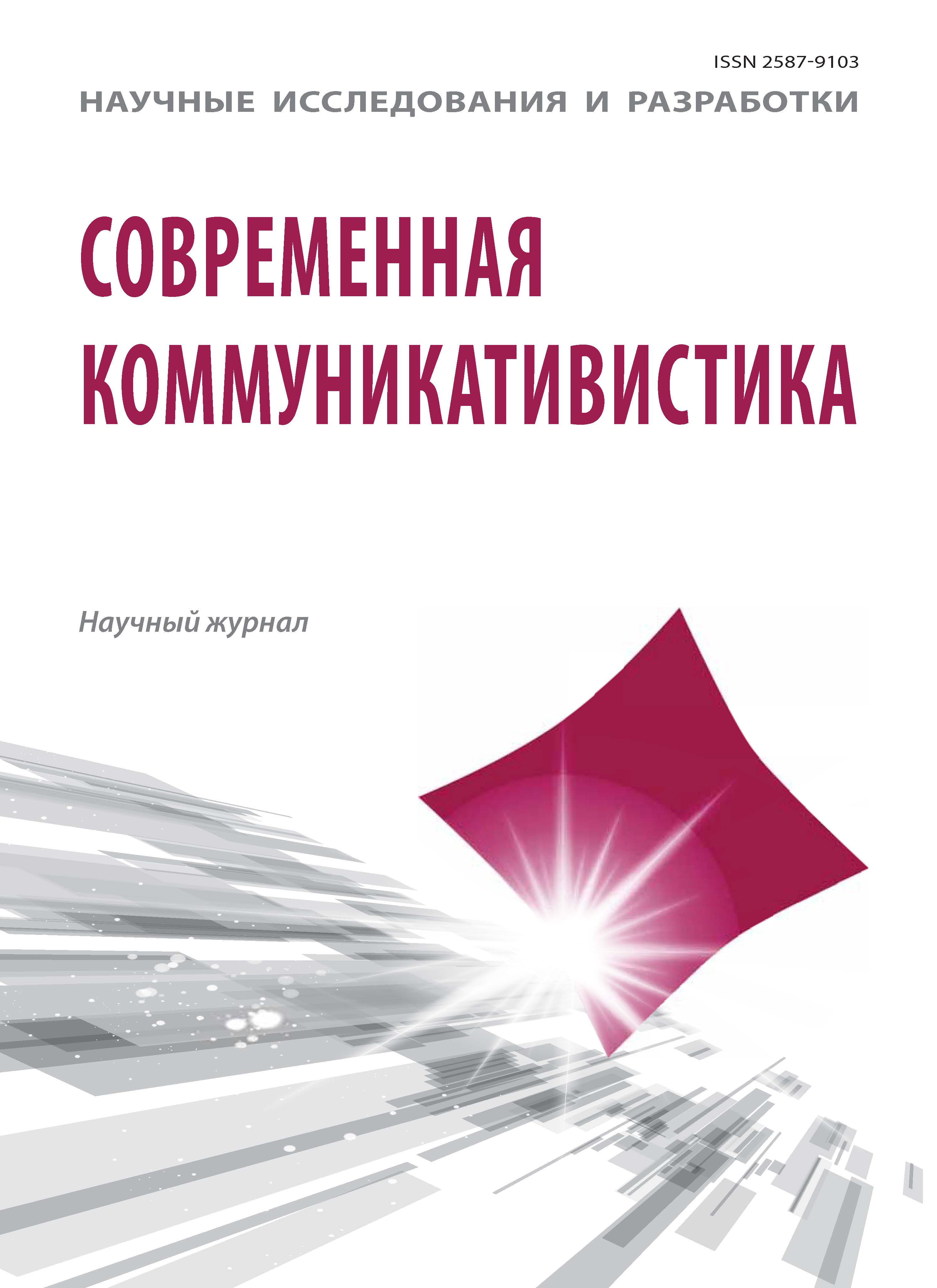Russian Federation
The article deals with issues related to modern communication studies. Particular attention is drawn to the factors that influence the creation of a particular image (in particular, the image of China) by means of language. Taking into account the influence of the media text on public opinion and the formation of a certain vision of the image of the country, both lexical, grammatical, and syntactic language possibilities are analyzed. Based on the understanding of today's features of communication associated with the expansion of the information field due to the widespread use of Internet technologies, social networks stand out as a tool for shaping public opinion and a "sounding" response to the most significant events not only on a national scale, but also on a global scale. The COVID-19 pandemic is becoming such an event that has affected all countries without exception. In the context of this problem, the authors propose to analyze a large amount of material collected in the Russian social network VKontakte (VK). The choice of VK is substantiated due to the great popularity among Chinese users, recognition, wide distribution as the only “recognizable” Russian social network. Describes the method of discourse analysis and the relevance of its application for this study. The paper presents an overview of the works of Russian and foreign scientists devoted to the study of discourse. Based on the regularities identified from the discourse analysis, a classification of "evaluative" means is proposed, based on semantic and word-formation approaches. The conclusion is made about the dynamics of the formation of a positive image of China in the social and communicative context of the Russian-speaking community.
modern communication science, discourse, discourse analysis, evaluation tools, social networks, fight against COVID-19, shaping the image of China, social media
1. Annenkova I.A. Sovremennaya mediakartina mira: neoritoricheskaya model (lingvofilosofskii aspekt): avtoref. dis. dok. filol. nauk. M., 2012. 60 s.
2. Ahmanova O.S. Slovar lingvisticheskih terminov. M.: KomKniga, 2005. 576 s.
3. Bagiyan A.YU., Nersesyan G.R. Pragma-kommunikativnii analiz ocenochnosti kak osnovopolagayush'ego instrumenta formirovaniya intencionalnogo mezhsubektnogo dialoga // Mezhdunarodnii elektronnii nauchnii zhurnal. 2018. № 3. 19 s.
4. Belousova D.V. YAzikovie sredstva kak instrument manipulyacii obsh'estvennim soznaniem v kommunikacii SMI i auditorii // Gumanitarnie tehnologii v sovremennom mire: sbornik statei X Mezhdunarodnoi nauchno-prakticheskoi konferencii (19-22 maya 2022 goda). - Kaliningrad: Poligrafich, 2022. S. 369-371.
5. Goncharova L.M. Kommunikativistika v vodovorote novih otkritii // Sovremennaya kommunikativistika. 2022. № 2 (57). S. 5-9.
6. Grachev M.A., Ionova S.V. Novie formuli politicheskogo yazika dlya virazheniya ocenki // Russkii yazik za rubezhom. 2019. № 4. S.19-25.
7. Greidina N.L. Mediinaya agressiya v kontekste politicheskoi kommunikacii (na materiale britanskih i amerikanskih SMI) // Nauchnie issledovaniya i razrabotki. Sovremennaya kommunikativistika. 2022. № 2 (57). S. 102- 106.
8. Iorgensen M. V., Fillips L. Dzh. Diskurs-analiz. Teoriya i metod / per. s angl. 2-e izd. Harkov: Gumanitarnii centr, 2008.
9. Kvadratura smisla: Francuzskaya shkola analiza diskursa. Per.s fr.i portug. / Obsh'. red. i vstup. st. P. Serio; predisl. YU.S. Stepanova. I.: OAO IG «Progress», 2002. 416 s.
10. Korpusnaya lingvistika. [Elektronnii resurs]. URL: https://ru.wikipedia.org/wiki/%D0%9A%D0%BE%D1%80%D0%BF%D1%83%D1%81%D0%BD%D0%B0%D1%8F_%D0%BB%D0%B8%D0%BD%D0%B3%D0%B2%D0%B8%D1%81%D1%82%D0%B8%D0%BA%D0%B0) (data obrash'eniya 20.11.22)
11. Kostomarov V.G. YAzikovoi vkus epohi: iz nablyudenii nad rechevoi praktikoi massmedia. M.: 1994. 247 s.
12. Kostomarov V.G. YAzik tekush'ego momenta: ponyatie pravilnosti. SPb.: Zlatoust, 2014. 220 s.
13. Li Lisin. Diskurs-analiz osvesh'eniya obraza zhensh'in v Kitae v gazete "Vashington post" // Filologicheskii akademicheskii zhurnal. 2019. № 6. S. 109-116.
14. Lyu Cyan. Obuchenie kitaiskih studentov russkomu yaziku vne yazikovoi sredi na materialah o koronaviruse [uroven V1] // Russkii yazik za rubezhom. 2022. № 3. S.107-114.
15. Minyar-Belorucheva A.P., Sergienko P.P. Multimodalnii podhod k rassmotreniyu lingvisticheskih sredstv virazheniya PR-kampanii, napravlennih na borbu s pandemiei v cifrovuyu epohu // Sovremennaya kommunikativistika. 2022. № 2 (57). S.107-114.
16. Muhaev R.T., Laamarti YU.A. Internet-kommunikacii kak instrument formirovaniya politicheskoi kulturi rossiiskoi molodezhi: empiricheskii analiz // Sovremennaya kommunikativistika. 2022. № 2 (57). S.89-101.
17. Oleshkova A.M. Kriticheskii diskurs-analiz v tradicii N. Ferklo: socialno-filosofskii aspekt // Mezhdunarodnii nauchno-issledovatelskii zhurnal ▪ № 6 (96) ▪ CHast 4 ▪ Iyun 15. S. 15-18. [Elektronnii resurs]. URL: https://cyberleninka.ru/article/n/kriticheskiy-diskurs-analiz-v-traditsii-n-ferklo-sotsialno-filosofskiy-aspekt (data obrash'eniya 8.11.22).
18. Parshin P. B. Rechevoe vozdeistvie // Virtualnaya enciklopediya «Krugosvet». [Elektronnii resurs]. URL: http://www.krugosvet.ru/ enc/gumanitarnye_nauki/lingvistika/RECHEVOE_ VOZDESTVIE.html?page=0,2 (data obrash'eniya: 10.11.2022).
19. Socialnie media. [Elektronnii resurs]. URL: https://ru.wikipedia.org/wiki/%D0%A1%D0%BE%D1%86%D0%B8%D0%B0%D0%BB%D1%8C%D0%BD%D1%8B%D0%B5_%D0%BC%D0%B5%D0%B4%D0%B8%D0%B0 (data obrash'eniya: 12.11.2022).
20. Socialnie seti v Rossii: cifri i trendi. Osen 2022. [Elektronnii resurs]. URL: https://br-analytics.ru/blog/social-media-russia-2022/ (data obrash'eniya 20.11.22).
21. Huan CHan. Predvzyatoe mnenie amerikanskih lidiruyush'ih media ob imidzhe Kitaya (na primere soobsh'enii, svyazannih s Kitaem, vo vremya epidemii Covid-19) // Inostrannaya filologiya. 2021. № 4. S. 85-96.
22. Czou Tyanci. Dinamika obraza Kitaya v sovremennih media // Gumanitarnie tehnologii v sovremennom mire: sbornik statei X Mezhdunarodnoi nauchno-prakticheskoi konferencii (19-22 maya 2022 goda). - Kaliningrad: Poligrafich, 2022. S.103-106.
23. Cyui Veni, [R.] I. Golimbickii. Pandemiya koronavirusa novogo tipa s tochki zreniya Rossii: rol Kitaya, konkurenciya mezhdu SSHA i Kitaem, a takzhe vibor Rossii // Rossiiskie issledovaniya v Vostochnoi Evrope i Centralnoi Azii. 2020. № 4. S. 56-80.
24. CHzhan CHunbo. Kodirovanie i dekodirovanie imidzha Kitaya v videorolikah i lichnih publikaciyah na YouTube // Vestnik Stolichnogo pedagogicheskogo universiteta. 2014. № 3. S. 70-77.
25. CHto takoe socialnie media? [Elektronnii resurs]. URL: https://smmplanner.com/blog/chto-takoie-sotsialnyie-miedia-kakoie-miesto-v-nikh-zanimaiut-sotssieti-razbiraiemsia/ (data obrash'eniya 15.11.22)
26. Fairclough, N. Critical Discourse Analysis: The Critical Study of Language. London: Routledge, 2010.
27. Fairclough N. The Dialectics of Discourse [Electronic resource]. URL: https://www.sfu.ca/cmns/courses/2012/801/1- Readings/Fairclough%20Dialectics%20of%20Discourse%20Analysis.pdf (accessed:15.04.2020).
28. Fowler, R. Language in the News: Discourse and Ideology in the Press[M]. Abingdon & New York: Routledge, 2013.
29. Jonathan Obar, Steven Wildman. Social Media Definition and the Governance Challenge - An Introduction to the Special Issue. - Rochester, NY: Social Science Research Network, 2015-07-22. - № ID 2663153.
30. Solis D. The definition of social media. URL: http://www.webpronews.com/blogtalk/2007/06/29/the -definition-of-social-media Citiruetsya po Vikipedii. Socialnie media https://ru.wikipedia.org/wiki/%D0%A1%D0%BE%D1%86%D0%B8%D0%B0%D0%BB%D1%8C%D0%BD%D1%8B%D0%B5_%D0%BC%D0%B5%D0%B4%D0%B8%D0%B0 (data obrash'eniya: 20.11.2022).







